Did you know over 60% of chronic diseases could be prevented with better dietary choices? Modern research shows certain foods do more than just fill your stomach—they actively boost your health and shield your body from illness.
These special ingredients, called functional foods, offer extra health benefits beyond basic nutrition. From reducing inflammation to improving gut health, they play a key role in disease prevention strategies worldwide.
Countries like those in the EU already use them to fight obesity and diabetes. Now, more Americans are turning to science-backed options to enhance their diet and long-term wellness.
Key Takeaways
- Functional foods provide benefits beyond basic nutrition
- They help prevent chronic diseases like diabetes and heart conditions
- Gut health improvement is a major research focus area
- Dietary choices directly impact disease risks
- Consumer demand for evidence-based ingredients keeps growing
Want to upgrade your meals? Try these healthy smoothie recipes packed with functional ingredients.
Introduction to Functional Foods
Long before modern science confirmed their benefits, cultures worldwide relied on nutrient-packed foods for vitality. These ingredients, now called functional foods, bridge ancient wisdom and modern *health* research.

What Are Functional Foods?
Functional foods go beyond basic nutrition. They contain bioactive compounds—like polyphenols in olive oil or probiotics in yogurt—that support bodily functions. Think of them as your diet’s secret weapons against chronic conditions.
Historical Context and Modern Relevance
Fermented foods like kimchi and miso have been staples for millennia. The Mediterranean diet, rich in olives and fish, unknowingly delivered heart-protective *dietary* benefits. Today, science explains why these traditions worked.
Global *health* disparities reveal stark contrasts. For example, EU populations with higher fruit/vegetable intake show lower diabetes rates. Meanwhile, processed diets dominate regions with rising obesity.
- Ancient to modern: Fermented foods → fortified cereals
- Diet shifts: Processed foods correlate with chronic disease spikes
- Global innovation: Cross-cultural research fuels new functional products
A 1996 American Dietetics Association report highlighted plant-based diets for cancer prevention—a finding that still guides *modern relevance* today. As food systems evolve, so does our understanding of these powerful ingredients.
The Science Behind Functional Foods in Disease Prevention
Science reveals how specific substances in food actively combat illness. These bioactive compounds trigger cellular responses that reduce chronic disease risk. Unlike ordinary nutrients, they target inflammation, oxidative stress, and immune function.
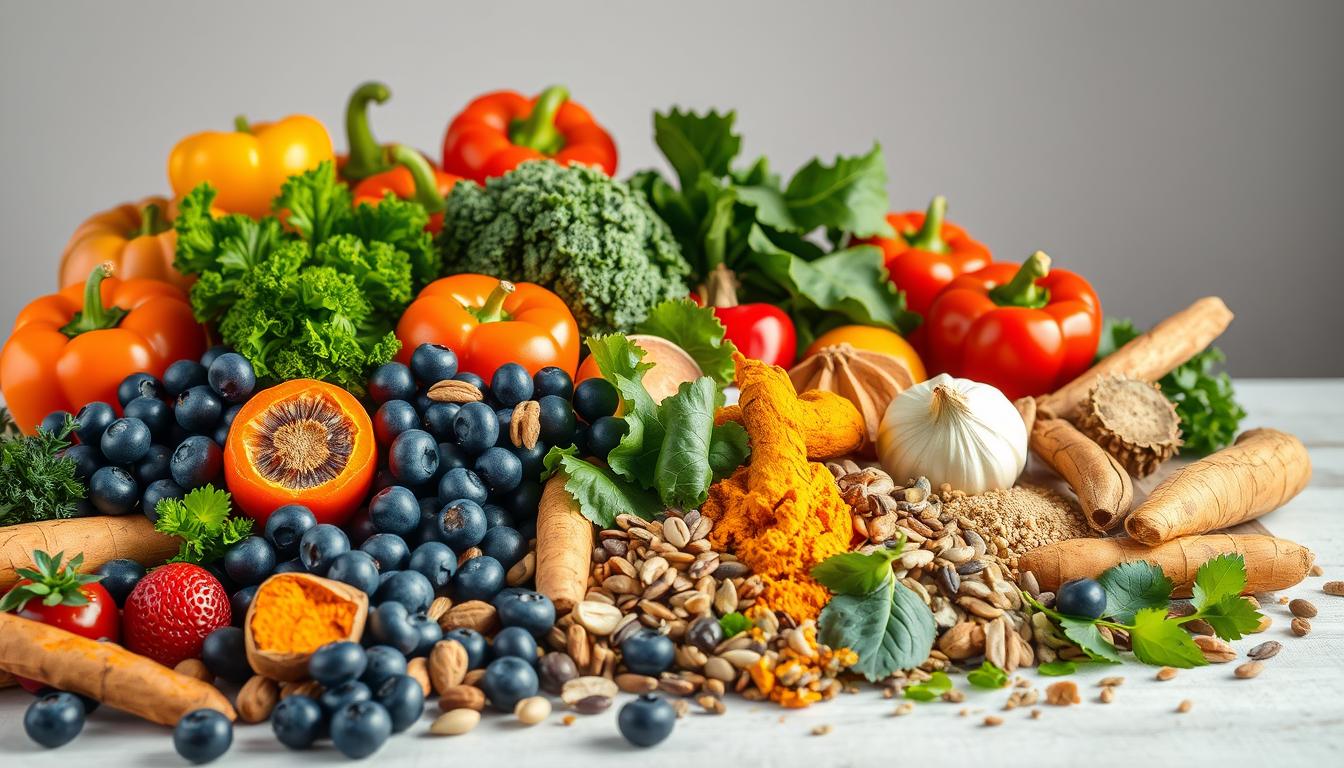
How Functional Foods Interact with the Body
Sulforaphane in broccoli activates the Nrf2 pathway, a master regulator of antioxidants. This process helps cells detoxify harmful molecules linked to cancer. Studies show effects within hours—like anthocyanins in berries improving blood vessel function.
Omega-3 fatty acids from fish inhibit COX-2 enzymes, reducing anti-inflammatory signals. Quercetin, found in apples, blocks histamine release, easing allergy symptoms. Each compound works like a precision tool for health.
Key Mechanisms: Antioxidants, Anti-Inflammatory Effects, and More
Polyphenols in dark chocolate protect LDL cholesterol from oxidation, lowering atherosclerosis risk. Antioxidants neutralize free radicals, while anti-inflammatory agents quiet overactive immune responses.
- Nrf2 activation: Shields DNA from damage (e.g., cruciferous veggies)
- COX-2 inhibition: Reduces joint pain (omega-3s)
- Endothelial support: Boosts circulation (berries, tea)
These mechanisms explain why diets rich in plants correlate with lower cancer rates. Your plate isn’t just meals—it’s molecular medicine.
Types of Functional Foods and Their Components
Modern supermarkets stock edible armor against chronic conditions. These scientifically validated ingredients work through distinct mechanisms—from gut modulation to cholesterol management. Knowing which to choose maximizes their protective effects.
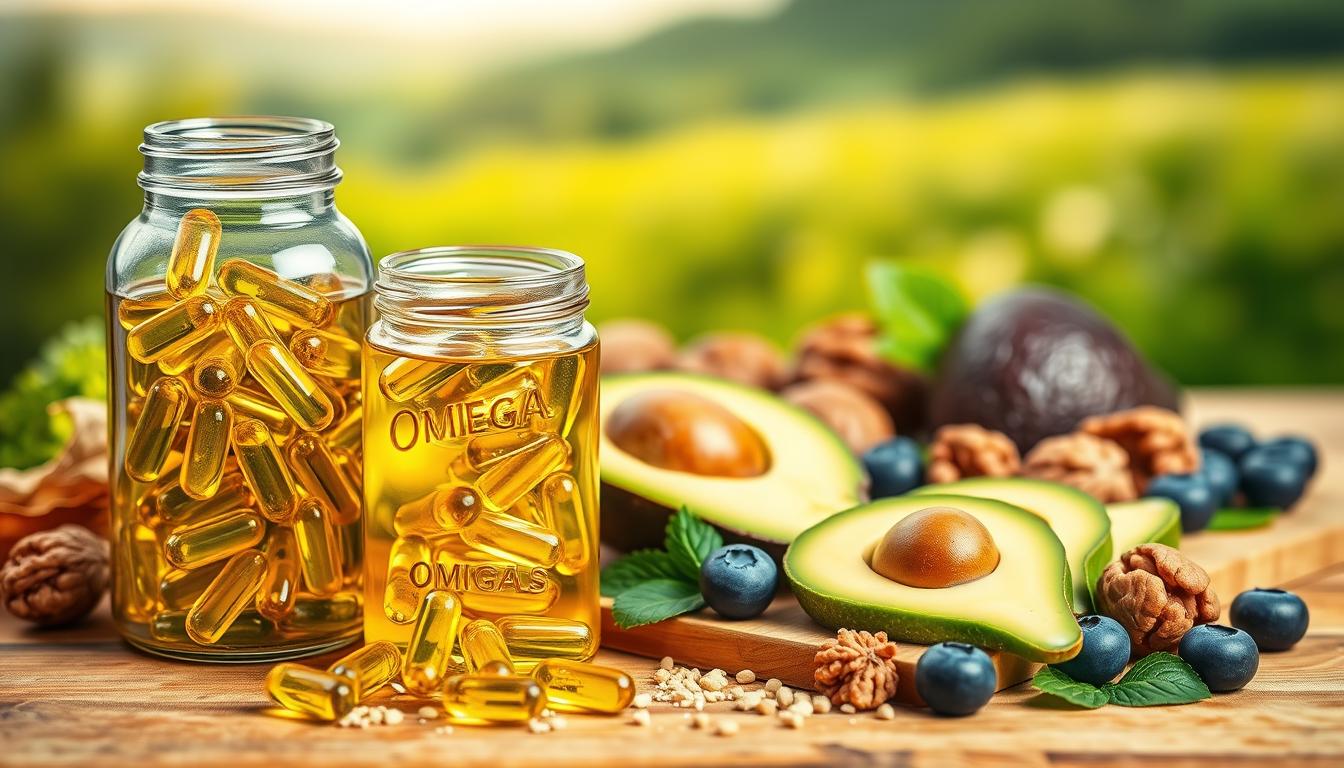
Probiotics and Fermented Foods
Live cultures in yogurt, kefir, and kimchi repopulate your gut microbiome. Studies show specific strains like Lactobacillus reduce IBS symptoms by 30%. Fermentation also increases nutrient bioavailability—sauerkraut offers 20x more vitamin C than raw cabbage.
Prebiotics and Dietary Fibers
These indigestible fibers feed beneficial gut bacteria. Jerusalem artichokes and garlic contain inulin, which boosts calcium absorption by 20%. Soluble fibers in oats form gels that slow sugar absorption, helping manage diabetes risk.
Plant Sterols and Omega-3 Fatty Acids
Plant sterols block cholesterol absorption in the gut. Just 2g daily—found in fortified margarines—lowers LDL by 10% without affecting HDL. The GISSI-Prevenzione trial proved omega-3s reduce cardiovascular events by 45% in high-risk patients.
| Source | EPA/DHA Content | Absorption Rate | Considerations |
|---|---|---|---|
| Fish Oil | 30% concentration | Moderate | May interact with blood thinners |
| Krill Oil | 15% concentration | High (phospholipid-bound) | Lower mercury risk |
Note: Stanol ester margarines may reduce absorption of beta-blockers. Space intake by 2 hours for optimal medication efficacy. For omega-3 supplementation, algae oil offers vegan DHA with comparable bioavailability to fish sources.
Functional Foods and Cardiovascular Health
Certain foods act like natural medicine for your arteries. Research proves bioactive compounds in everyday ingredients can lower cardiovascular risk by targeting key dietary factors. From tomatoes to walnuts, these choices work synergistically with your body’s defenses.

Reducing Cholesterol and Blood Pressure
Pomegranate polyphenols preserve nitric oxide, keeping blood vessels flexible. A 2021 study showed daily consumption lowered systolic pressure by 5 mmHg. Green tea’s EGCG inhibits MMP-9 enzymes, reducing arterial stiffness.
Lycopene in cooked tomatoes slows atherosclerosis progression. Third-party trials found 0.1mm yearly reduction in carotid thickness. Plant sterols in nuts and seeds block cholesterol absorption at the gut level.
Role in Preventing Atherosclerosis
The MESA study revealed nut lovers had 20% lower coronary calcium scores. This measures plaque buildup—a key marker for atherosclerosis risk. Antioxidants in berries and dark chocolate prevent LDL oxidation, stopping plaque formation.
Foods fighting inflammation also protect your heart. Turmeric’s curcumin reduces C-reactive protein levels by 30% in high-risk groups. Simple swaps like olive oil for butter make these benefits effortless.
Gut Health and Functional Foods
Trillions of bacteria in your gut respond to what you eat daily. Research shows specific ingredients can rebalance your microbiome, offering health benefits beyond digestion. These foods work like tuning forks for your intestinal ecosystem.

Probiotics for Irritable Bowel Syndrome
Live cultures in yogurt and fermented foods ease IBS symptoms by 30%. They produce butyrate—a fatty acid that tightens gut junctions. This reduces “leaky gut” syndrome and inflammation.
Not all fibers work equally:
- Acacia fiber: Gentle for sensitive stomachs (90% tolerability)
- Inulin: May cause bloating in 40% of IBS patients
Prebiotics and Microbiome Balance
Galactooligosaccharides—found in lentils—increase bifidobacteria tenfold in two weeks. These dietary fibers feed good bacteria while reducing harmful TMAO levels.
Whole grains outperform supplements for microbiome diversity. A 2023 study showed oat bran cut TMAO (linked to heart risk) by 18% versus isolated fibers.
Functional Foods in Cancer Prevention
Bioactive compounds in everyday foods actively disrupt cancer development pathways. These substances target tumors through multiple mechanisms—from blocking DNA damage to starving malignant cells. Research confirms dietary choices significantly impact genetic expressions linked to abnormal growth.
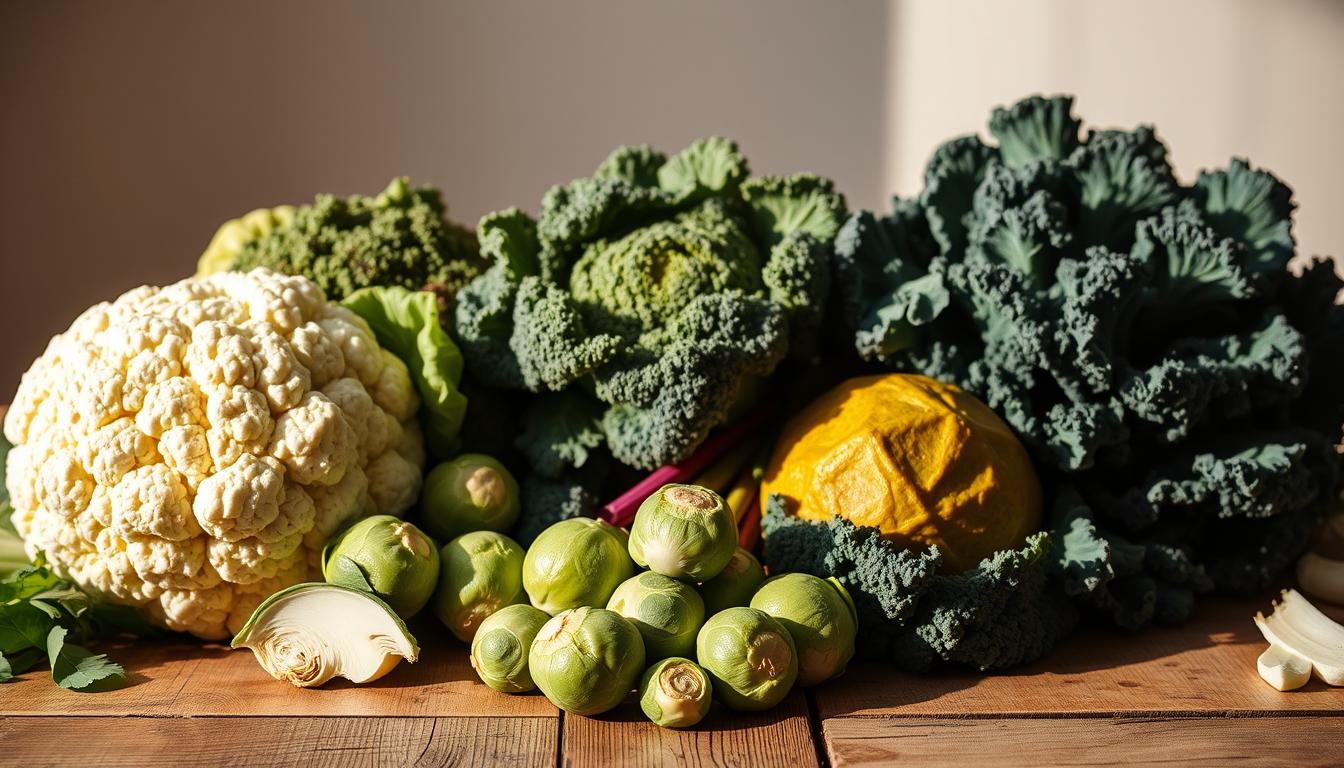
Anticarcinogenic Properties of Polyphenols
Polyphenols in berries and green tea induce cancer cell apoptosis (programmed death). They inhibit angiogenesis—the process tumors use to grow blood vessels. A 2022 Nutrients journal study showed quercetin from apples suppresses breast cancer protein markers by 37%.
Cruciferous Vegetables and Cancer Risk Reduction
Broccoli and Brussels sprouts contain glucosinolates that convert to isothiocyanates during chewing. These compounds enhance detoxification enzymes, especially in smokers. Consuming 5+ weekly servings reduces lung cancer risk by 40%, per NIH data.
Your GST genotype affects how well you process these cruciferous vegetables. Fast metabolizers see greater protection—up to 60% lower bladder cancer incidence. The Shanghai Women’s Health Study linked high intake to 32% reduced breast cancer risk.
- Glucosinolate conversion: Myrosinase enzymes activate when cell walls break during chewing
- Genetic factors: GSTT1 null genotypes may require higher cruciferous intake
- Synergistic effects: Pairing with selenium-rich foods boosts detox pathways
Steaming preserves 90% of anticancer compounds versus boiling’s 40% loss. For optimal prevention, include diverse plant foods that target multiple cancer hallmarks simultaneously.
Diabetes Management Through Functional Foods
Your plate holds powerful tools for balancing blood sugar naturally. Research confirms certain ingredients improve glucose control better than others. These choices target risk factors like insulin resistance and inflammation.
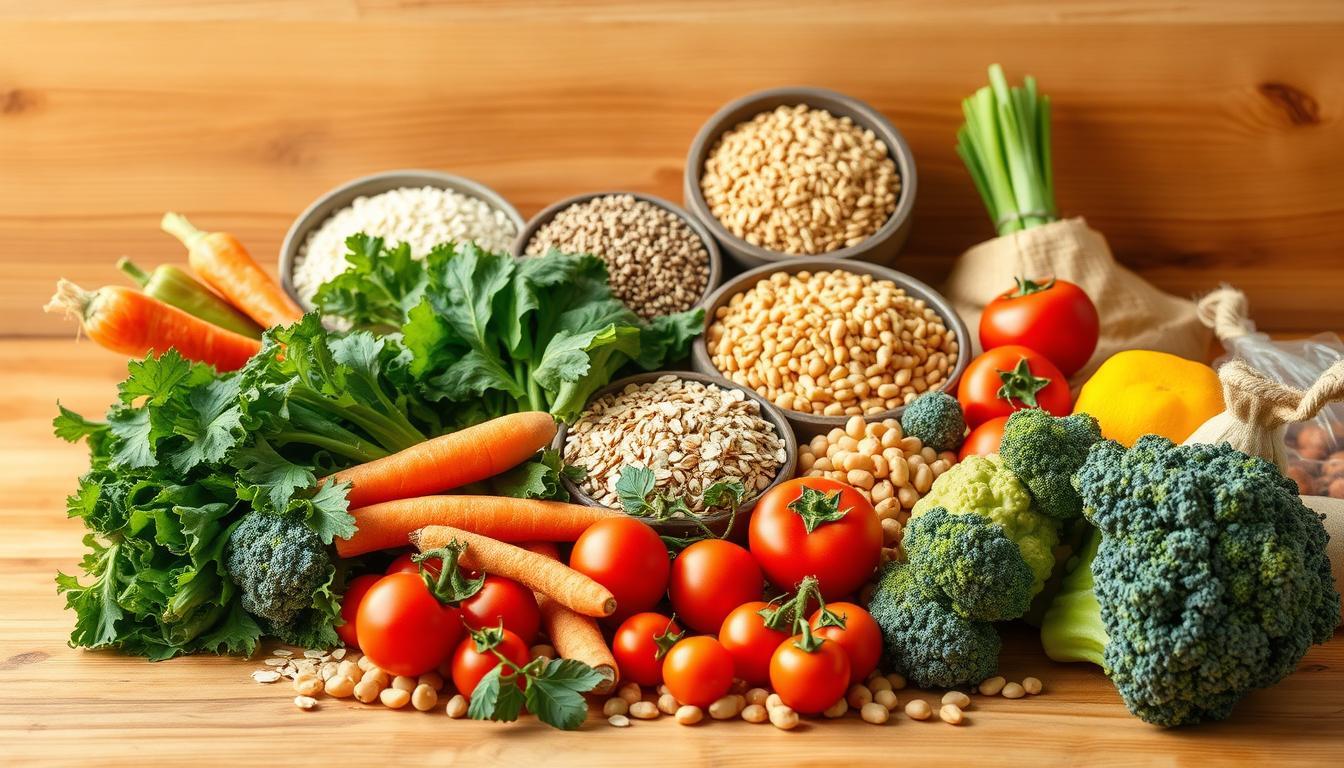
Blood Sugar Regulation with Fiber-Rich Foods
Soluble fibers form gels that slow sugar absorption. Pumpkin seeds deliver magnesium—a mineral that boosts insulin sensitivity by 10%. The PREDIMED trial proved Mediterranean dietary patterns reduce diabetes incidence by 40%.
Lentils show particular promise. Daily consumption lowers HbA1c by 0.5% in three months. Their resistant starch feeds gut bacteria that produce blood sugar-regulating compounds.
Role of Whole Grains and Legumes
Unlike refined carbs, whole grains release energy gradually. Compare these glycemic impacts:
| Food | Glycemic Index | Fiber (g per serving) | Blood Sugar Impact |
|---|---|---|---|
| Quinoa | 53 | 5 | Gradual rise |
| White Rice | 73 | 0.6 | Sharp spike |
Legumes like black beans combine fiber with protein for sustained energy. Their phytates may enhance insulin receptor function. For optimal benefits, pair them with vitamin C-rich foods to boost iron absorption.
Simple swaps make a difference. Choosing steel-cut oats over cereal flakes can lower post-meal glucose by 30%. These reduction strategies work cumulatively over time.
Immune System Support
Your immune system gets daily reinforcements from what’s on your plate. Certain foods enhance your body’s defenses better than others. They work through multiple pathways—from boosting protective antibodies to calming harmful inflammation.

Vitamin-Rich Fruits and Vegetables
Brightly colored produce delivers immune-critical nutrients. Red bell peppers offer triple the vitamin C of oranges. This antioxidant protects immune cells from oxidative damage during immune response.
Leafy greens provide folate for white blood cell production. Studies show people eating 5+ daily servings have 20% fewer sick days. Beta-carotene in sweet potatoes enhances pathogen-fighting NK cell activity.
Fermented Foods and Immune Response
Fermented foods like kefir increase salivary IgA by 35%. These antibodies act as first-line defenders against pathogens. The probiotics in them activate TLR-4 receptors—your immune system’s alarm system.
Korean research found kimchi eaters recovered from flu 2 days faster. Specific strains like Bifidobacterium longum regulate histamine levels. This reduces allergy-related immune overreactions.
| Food | Active Component | Immune Benefit | Serving Suggestion |
|---|---|---|---|
| Kefir | Lactobacillus kefiri | Boosts IgA antibodies | 1 cup daily |
| Kimchi | Leuconostoc mesenteroides | Reduces flu duration | 2 tbsp with meals |
| Miso | Aspergillus oryzae | Enhances NK cell activity | 1 tsp in soups |
For optimal effects, combine vitamin-packed produce with cultured foods. This dual approach supports both immediate immune response and long-term microbiome balance. Your gut houses 70% of immune cells—feed them well.
Functional Foods for Brain Health
Cognitive decline isn’t inevitable—certain foods actively protect your neurons. Research confirms that dietary choices significantly impact memory, focus, and long-term brain function. These neuroprotective ingredients work through multiple pathways to maintain mental sharpness.

Omega-3s and Cognitive Function
DHA from fish oil constitutes 30% of brain matter. This fatty acid enhances neuron membrane fluidity, improving signal transmission. Studies show seniors with higher omega-3 levels maintain better recall abilities.
Not all sources work equally:
| Source | DHA Content (mg per serving) | Absorption Advantage |
|---|---|---|
| Wild Salmon | 1,200-2,400 | Natural phospholipid structure |
| Algae Oil | 400-600 | Vegan-friendly, no mercury |
| Flaxseeds | 0 (contains ALA) | Only 5% converts to DHA |
Anthocyanins in berries cross the blood-brain barrier within four hours. These compounds reduce oxidative stress in hippocampal regions critical for memory.
Antioxidants and Neuroprotection
Curcumin in turmeric inhibits amyloid-beta aggregation by 40%. This neuroprotection mechanism may delay Alzheimer’s progression. Pair it with black pepper to boost absorption 2000%.
Broccoli sprouts provide sulforaphane—a precursor for glutathione synthesis. This master antioxidant defends neurons against toxic compounds. Just ½ cup daily raises protective enzymes.
- The Rotterdam Study linked high flavonoid intake to 40% lower Parkinson’s risk reduction
- Dark chocolate flavonoids improve cerebral blood flow within two hours
- Walnuts contain melatonin precursors that regulate brain circadian rhythms
For optimal brain benefits, combine these foods regularly. Your neurons constantly rebuild—feed them the right materials.
Weight Management and Obesity Prevention
Smart food swaps can shrink your waistline while keeping you full. Choosing low-energy-dense options lets you eat satisfying portions without excess calories. This dietary approach tackles one of America’s biggest health challenges—obesity prevention.

Maximizing Satiety with Strategic Choices
Mushrooms can replace 40% of meat in recipes, cutting calories while maintaining texture. Their high water content creates bulk that triggers stretch receptors in your stomach. This biological trick helps you feel satisfied with fewer calories.
Compare these volumetrics:
| Food | Calories per Cup | Satiety Index Score |
|---|---|---|
| Zucchini Noodles | 20 | 85% of regular pasta |
| White Pasta | 220 | 100% baseline |
The Science of Low-Energy-Dense Foods
Konjac glucomannan absorbs 50x its weight in water, forming a gel that slows digestion. This soluble fiber appears in shirataki noodles—a popular low-energy-dense alternative. It expands in your stomach, sending fullness signals to your brain.
CDC research reveals regular soup eaters have:
- 4% lower average BMI
- 31% higher vegetable intake
- Reduced risk of metabolic syndrome
These strategies prove obesity prevention doesn’t require deprivation. By focusing on food physics rather than willpower, you can reshape your eating habits sustainably.
Bone Health and Functional Foods
Strong bones require more than calcium—they thrive on synergistic nutrient combinations. Your skeleton undergoes constant remodeling, replacing 10% of its mass yearly. This process demands precise dietary support to prevent age-related decline.
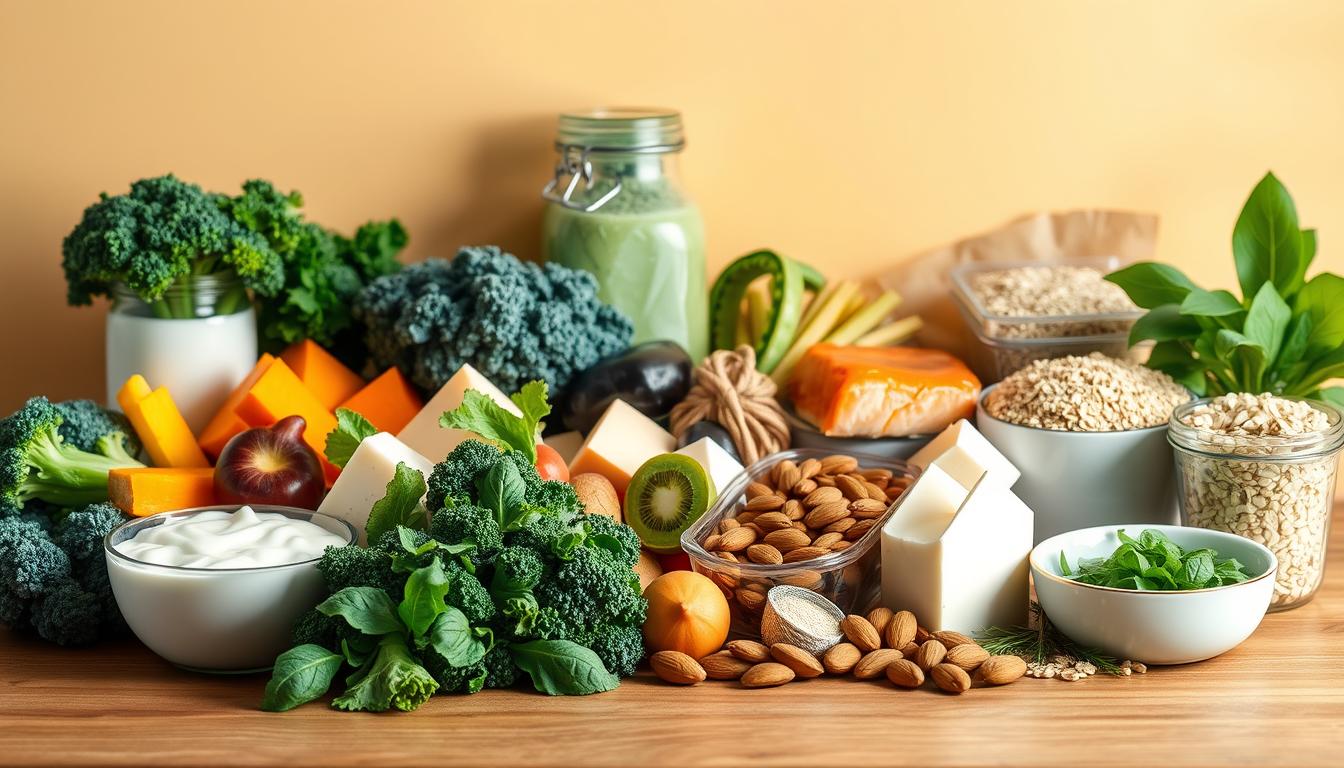
Calcium-Fortified Foods and Alternatives
While dairy provides calcium, fortified plant milks offer comparable health benefits for lactose-intolerant individuals. Magnesium acts as a cofactor, helping transport calcium into bone matrix. Almonds and pumpkin seeds deliver both minerals naturally.
Boron, found in raisins and prunes, enhances calcium retention by 30%. The RECORD trial showed combined calcium and vitamin D supplementation reduced fracture risk by 16% in seniors.
Vitamin D Synergy
UV-treated mushrooms provide 400 IU vitamin D per serving—a vegan alternative to fatty fish. This nutrient activates VDR receptors that regulate calcium absorption. For optimal synergy, pair them with magnesium-rich foods like spinach.
Clinical data confirms this combination:
- 55% lower hip fracture risk with adequate D3 levels
- 20% better calcium uptake when magnesium levels are sufficient
- Boron’s role in reducing urinary calcium excretion
Skin Health and Anti-Aging Benefits
Radiant skin starts from within, with bioactive compounds that fight wrinkles and dryness. Research confirms certain foods boost collagen and protect against UV damage better than topical products. These edible solutions work at the cellular level for lasting results.

Collagen-Boosting Foods
Bone broth provides glycine and proline—amino acids that rebuild skin structure. A 2023 Journal of Cosmetic Dermatology study showed daily intake improved skin elasticity by 28% in 12 weeks. Vitamin C-rich foods like bell peppers activate collagen-producing enzymes.
Key sources compared:
| Food | Collagen Support Nutrients | Bioavailability |
|---|---|---|
| Citrus Fruits | Vitamin C (90mg/medium orange) | High (water-soluble) |
| Egg Whites | Proline (1.5g per large egg) | Medium (requires digestion) |
| Shellfish | Zinc + Copper (oysters: 673% DV zinc) | High (mineral form) |
Polyphenols and Skin Benefits
Polyphenols in green tea and dark berries inhibit MMP-1 enzymes that break down collagen. The RESVAGE trial found resveratrol from grapes reduced facial redness by 31% in rosacea patients. Pycnogenol® (maritime pine bark extract) boosts hydration 25% by preserving hyaluronic acid.
Top performers for skin elasticity:
- EGCG: Green tea’s main antioxidant blocks 60% of UV-induced collagen damage
- Astaxanthin: This salmon-derived carotenoid provides cumulative sun protection when consumed daily
- Pomegranate ellagitannins: Stimulate fibroblast activity for natural plumping
For optimal risk reduction against premature aging, combine these foods with sun protection. Your skin repairs itself nightly—feed it the right building blocks.
Incorporating Functional Foods into Your Diet
Your grocery cart can become a powerful health tool with the right selections. Transitioning to a functional eating pattern doesn’t require drastic changes—just smarter choices. Start by adding one new functional ingredient each week to gradually upgrade your meals.
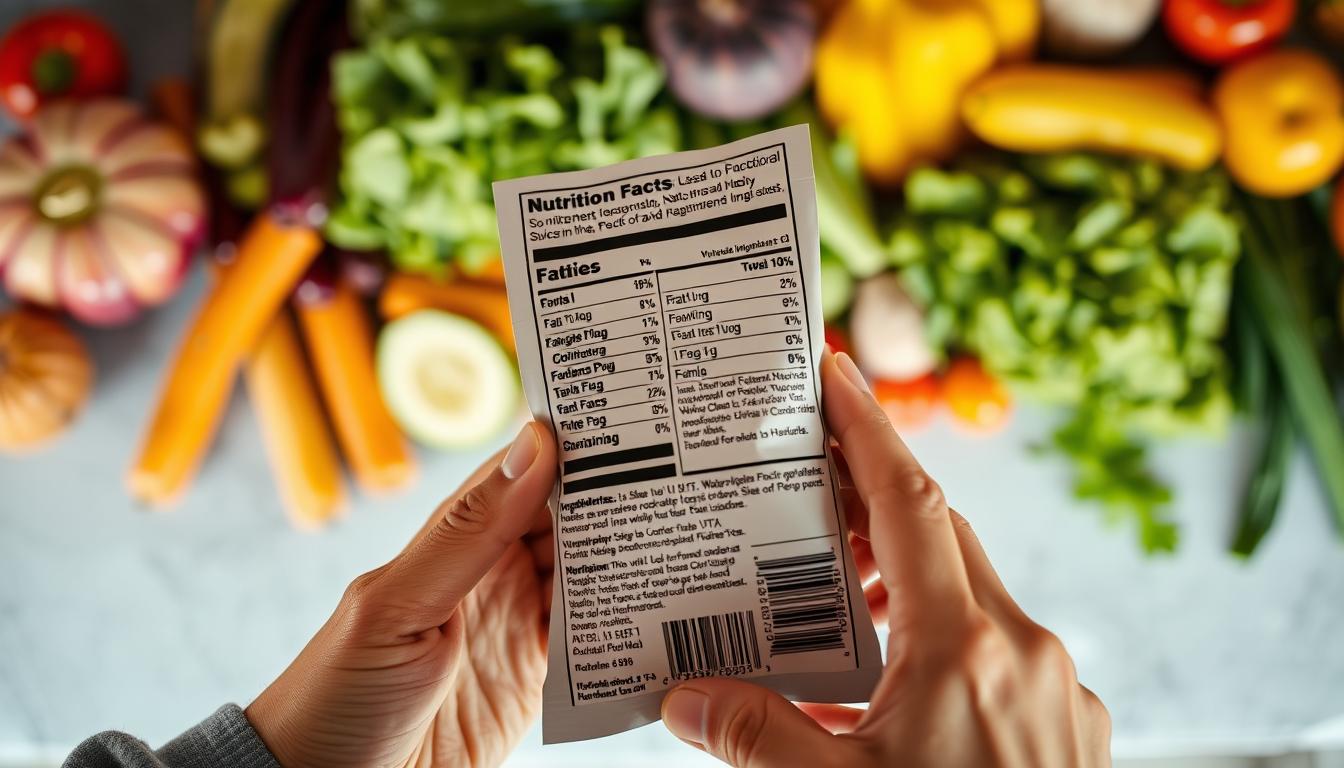
Practical Tips for Daily Meals
Swap white rice for quinoa to add protein and fiber to your dietary routine. The extra nutrients support blood sugar control while keeping you full longer. Try these simple upgrades:
- Blend spinach into smoothies for lutein without altering taste
- Use turmeric with black pepper to boost absorption 20x
- Choose fermented dairy like kefir over regular milk
Registered dietitian Maya Feller notes:
“Strategic food pairings can multiply health benefits. Always combine vitamin C-rich foods with plant-based iron sources for optimal absorption.”
Reading Labels for Functional Ingredients
Not all health claims indicate meaningful benefits. The FDA requires “high in omega-3” products to contain ≥320mg EPA/DHA per serving. Watch for these distinctions:
| Claim | Actual Meaning | Look For |
|---|---|---|
| “Bifidogenic” | May support specific gut bacteria | FOS or GOS fibers |
| “Prebiotic” | Feeds multiple beneficial strains | Inulin, resistant starch |
| “Antioxidant-rich” | Contains some protective compounds | ORAC value ≥5,000 |
Third-party certifications provide extra assurance. The NSF mark verifies supplement purity, while Non-GMO Project certification ensures cleaner functional ingredients. Always check the ingredients list—some probiotic drinks contain more sugar than beneficial cultures.
With practice, you’ll spot truly beneficial products quickly. Your dietary choices become simpler when you know what those labels really mean.
Challenges and Considerations
Your medicine cabinet might clash with your grocery list in unexpected ways. While functional ingredients offer health benefits, they require smart integration with medications and critical evaluation of marketing claims. Understanding these risk factors ensures safe, effective use.
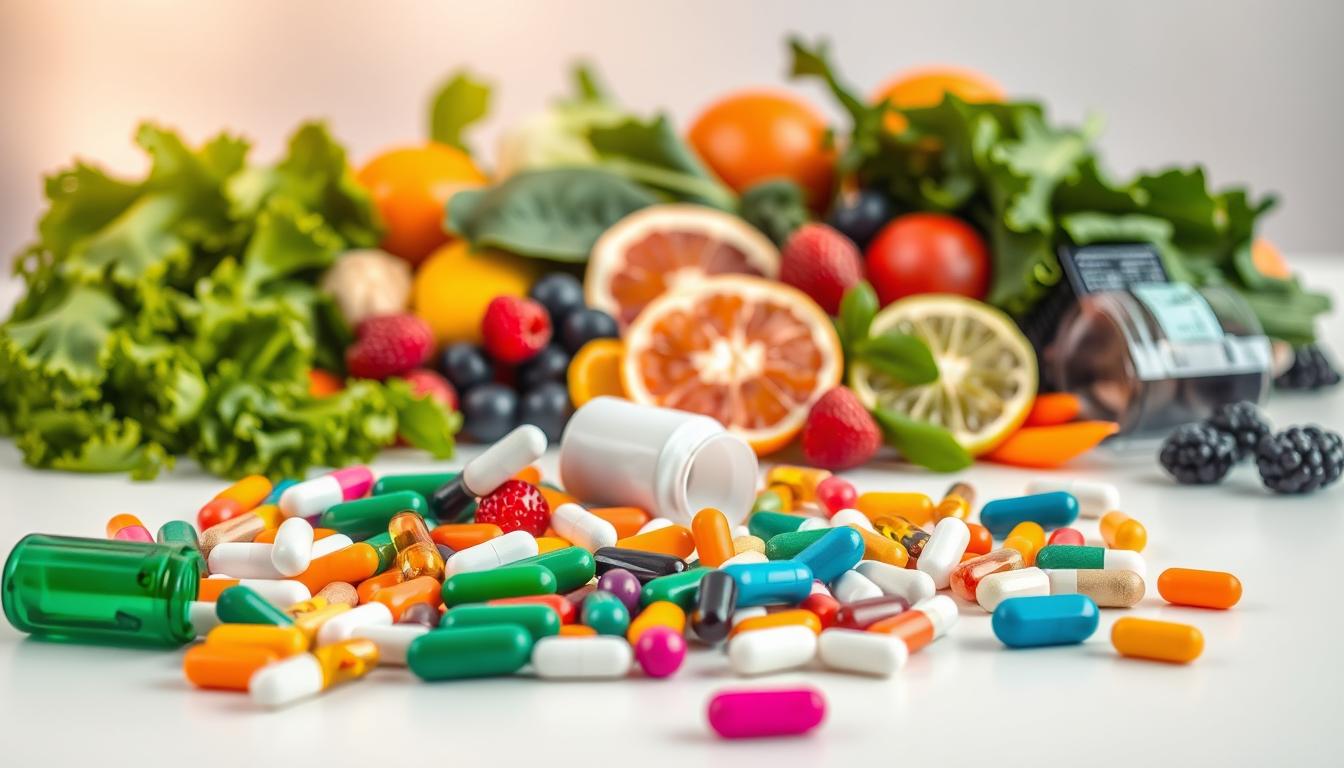
Navigating Marketing Claims vs. Evidence
“Clinically proven” labels often lack specifics. The FDA allows structure claims (e.g., “calcium builds strong bones”) but prohibits disease treatment claims without drug approval. Look for:
- PubMed-indexed studies referenced on packaging
- Third-party verification seals (NSF, USP)
- Dosage transparency for active compounds
Registered dietitian Lori Zanini warns:
“Many ‘gut-health’ products contain probiotic strains that haven’t demonstrated clinical efficacy in humans. Strain specificity matters.”
Potential Interactions with Medications
Grapefruit inhibits CYP3A4 enzymes for 72 hours, affecting:
- Statins (increased toxicity risk)
- Blood pressure drugs (dangerous drops)
- Immunosuppressants (reduced efficacy)
Calcium-rich foods interfere with thyroid medications when consumed within 4 hours. The ASHP recommends spacing them to avoid 30% absorption reduction. Warfarin users must maintain consistent vitamin K intake—sudden spinach increases alter INR values.
For optimal safety:
| Interaction | Time Buffer | Monitoring Needed |
|---|---|---|
| Green tea + Warfarin | 2 hours | INR tests weekly |
| Ginger + Blood thinners | 8 hours | Bruising signs |
Always consult your pharmacist about dietary changes when taking prescription drugs. These interactions underscore why personalized medical advice beats generic health claims.
Future Trends in Functional Food Research
Your DNA might soon dictate what’s on your dinner plate. Emerging technologies are unlocking personalized approaches to nutrition, while sustainable sourcing methods address environmental concerns. These parallel innovations will redefine how we think about dietary choices.
Personalized Nutrition and Genomics
Companies now analyze genetic markers to recommend ideal foods. A 2023 study found people following DNA-based diets lost 30% more weight than control groups. Your APOE genotype, for example, determines whether saturated fats help or harm your health.
Key developments include:
- Microbiome testing kits that suggest probiotic strains
- AI platforms matching meals to metabolic profiles
- Nutrigenomic apps warning about caffeine sensitivity risks
Sustainable Sourcing Innovations
Algae-based omega-3s now reduce fishery dependence by 30%. Researchers are also transforming byproducts into functional ingredients:
| Upcycled Material | New Use | Benefit |
|---|---|---|
| Spent grain from breweries | Prebiotic fiber additive | Boosts gut bacteria diversity |
| Tomato pomace | Lycopene concentrate | Cardiovascular protection |
Vertical farming yields polyphenol-rich microgreens with 40% higher antioxidant levels than field crops. Life Cycle Assessments confirm plant-based options like pea protein create 80% fewer emissions than animal-derived alternatives.
These innovations prove tomorrow’s dietary solutions must work for both bodies and the planet. The future isn’t just about eating better—it’s about smarter systems from farm to fork.
Conclusion
Science-backed foods offer more than just nutrition—they actively protect your body. By focusing on functional foods, you unlock health benefits that combat inflammation, oxidative stress, and gut imbalances.
Traditional eating patterns and modern research agree: what you eat directly impacts disease prevention. Mediterranean staples like olive oil and fermented Asian foods prove timeless wisdom aligns with current science.
Start small—swap one processed item weekly for whole-food alternatives. Prioritize evidence-backed choices like berries over trendy supplements. Your diet evolves best through steady, informed changes.
Future breakthroughs will personalize nutrition further, but today’s knowledge already empowers smarter eating. Every meal is an opportunity to nourish and defend your body.